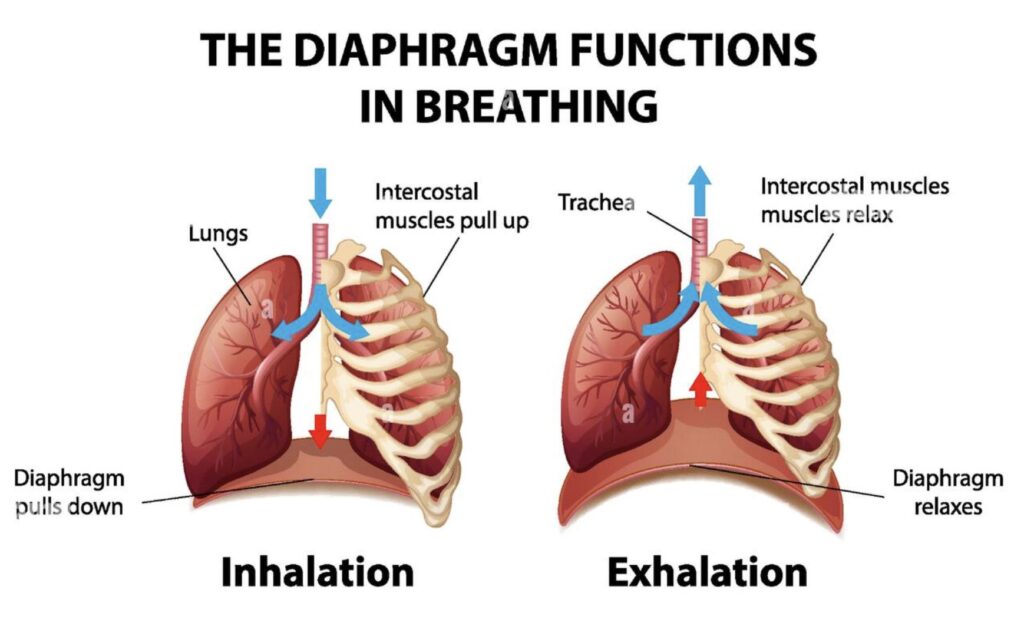Exhaaaaaaale…

No really, let’s all do this together….EXHAAAAAAAAAAAALE….yes, that’s better…
Chapter four of BREATH by James Nestor is titled “Exhale”, and he introduces us to some interesting stories of changing diaphragm malleability and lung capacity through different means to increase longevity and wellness. Once again, he refers to the practices and intuition of ancient sages who seemed to know the power of yoga movement and breath before the West began to study it so intensely.
“In the 1980’s, researchers with the Framingham Study, a 70-year longitudinal research program focused on heart disease, attempted to find out if lung size really did correlate to longevity. They gathered two decades of data from 5,200 subjects, crunched the numbers, and discovered that the greatest indicator of life span wasn’t genetics, diet, or the amount of daily exercise, as many had suspected. It was lung capacity.”
BREATH – Chapter 4 – by James Nestor
But how do we come by increased lung capacity? Many in early Western medicine believed that your internal organs were static and unchangeable. However, Nestor turns to the freediver’s knowledge of and ability toward changing their own breath capacity, and also shares two more fascinating stories from those he refers to as “pulmonauts”, adventurers and explorers in the field of breath.
This whole chapter made me think that BKS Iyengar himself would have been a good example of one of James Nestor’s “pulmonauts”. Like Carl Strough and his work with emphysemics, musicians, and athletes; and Katharina Schroth who worked with scoliotics; BKS Iyengar found ways to increase his own lung capacity through the work of yoga posture (asana) and breath regulation (pranayama). As a child, BKS Iyengar was physically weak and scrawny as he suffered from the effects of malaria, typhoid, and TB. Looking at images throughout his life and practice, you can SEE the increase in his chest size relating to the increase in his lung capacity and health. A boy who barely survived his youth, through yoga, lived an active and full life until the age of 96.
“What the bodily form depends on is breath (chi) and what breath relies upon is form,” states a Chinese adage from 700 AD. “When the breath is perfect the form is perfect (too).”
BREATH – Chapter 4 – by James Nestor
Manipulation of the body with the manipulation of the breath seems to be the pairing needed for ample results. Strough used subtle palpitation and tapping coupled with longer exhalations, while Schroth used more extreme stretching over furniture and trees coupled with what she termed “orthopedic breathing” to help herself and her patients. In The Yoga Sutras of Patanjali, a text dating back some 2500 years, the one clear step indicated in the 8-limbed process of yoga is that of “perfection of bodily posture (asana)” before learning the practices of breath regulation (pranayama) (Yoga Sutra II.49). This combination of breath and body movement remains a powerful catalyst for health. Iyengar Yoga also uses props to physically transform those who need it for better access to breath and movement together.
Changing your form, changes the ability for your organs to move and work more freely and properly. The diaphragm, which moves up and down accordingly with each breath, needs space to increase breath capacity and allow for freely working internal organs like the digestive system below and the heart above. Nestor makes the point that “curing” things may not be the point. For instance, lung damage from emphysema is permanent, but increased lung capacity allows use of good tissue that once was unavailable and allows the heart more room to pump more feely for increased circulation and energy. BKS Iyengar also has a popular quote to support this : “the practice of yoga can cure what can be cured, but teaches us to endure what cannot be cured”.
I even have my own “pulmonaut” anecdote when there is discussion about our Western ideas of what is “aerobic” and “non-aerobic” activity. I have been an “aerobic activity” doer for much of my life. Between running, swimming, biking, and weight lifting, I knew I was pretty strong and healthy. However, in any hiatus of swimming, I very typically needed some short swims to gain any stamina back…even if I had also been running. So, of course, when I had committed to yoga, and running slowly faded away (more due to bad ankles and knees than just not wanting to do it), I thought for SURE I would still need to build stamina starting back to swimming, or be even worse off since yoga is popularly seen as an “non-aerobic” activity. To my surprise, I got in the pool and swam for 45 minutes straight no problem – only got out of the pool because I had somewhere else to be! The combination of asana and pranayama I can personally attest to having a large effect on my overall stamina and physical wellness.
Unfortunately, even now, I do still feel like Western thought falls a bit behind in complete understanding of our FULL BEING and how it works together to keep us well and healthy over the long term. In Nestor’s research he sees over and over again the disregard of any “alternative” or “holistic” methods of healing. We treat someone medically as a representation of only one problem or issue that presents itself in one area or piece of the body. When in reality, we are a complex embodiment of physical structure, organic workings, energetic pulses and connections, and every element that makes up the universe. Yogis knew this long ago, and as years pass science keeps proving them right.
Keep joining us in reading Chapter 5 this week!